Knives one of the areas that warms a human heart, cooking, preparing meat, carving, first aid, hunting, and even fighting if needed. A knife or knives have been some of our first tools we as human developed, once we jumped from knapped flint to bronzes then iron and steel we have always had the developing of knives as a large part of our civilization.
Choosing a knife is like asking to pick a car... what are you going to use it for, what is your budget, what features do you want, what does it need to be made from, how much abuse will it get, how are you going to sharpen the blade, how sharp do you need to keep the blade, what blade shape and design do you need - and on and on....
In this case I am going to talk about a "general purpose" blade, if there ever was one of those in existence. For a bug out bag I would recommend a pocket knife or two, a pocket tool, and a "general purpose" tool type knife.
Knife parts
We can start with identifying the parts, types, and uses in the basic forms first, stick with me as I go over the elementary stuff, as this combined makes your choice clear.
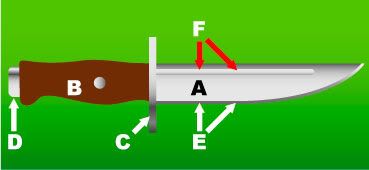
A. blade
B. handle
C. guard
D. pommel, butt or butt cap
E. the edge (the cutting sharpened surface, this is where the grind makes the cross section a sharpened edge)
F. fuller (when recessed often mistakenly called a "blood groove" - when elevated the crest)
The top edge, or thickest part of the blade (often not sharpened) is called the spine.
The fixed blade knife is composed of various parts, not all parts are present on every knife design, and some are cut from or moulded from the same material.
The edge grind
Lets review the properties of the edge grind - this is where you see the term grind, it is where the cross section is narrowed to a cutting edge. What are the basic types of grind?
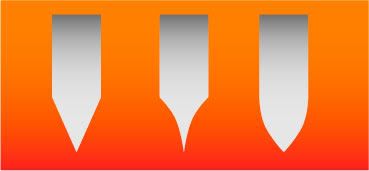
On the left is the sabre grind cross section (often mistaken for a flat grind), in the middle is the hollow grind cross section, and on the right is the convex grind cross section.
There are actually six common blade cross sections, including the compound edge referred to as a double bevel or compound bevel where the blade narrows then has an abrupt sabre grind at the very edge (actually the most common edge with most fixed blade "tool" knives.
A hollow grind is very sharp but will not keep it's edge (stay sharp) with extended use, hollow grinds are made with a circular grinding machine (like a grinding wheel or belt abrasive) and are fast to machine produce. When using a flat stone on a knife you will give the very edge a sabre grind, this grind will hold an edge longer but often will not have the butter like slicing effect a hollow grind will. The convex grind cross section takes a particular wrist movement on a flat stone or specialized tools but has the longest lasting edge for heavy use and chopping.
The Tang
The tang is simply the extension of the blade that fits into the handle, some blades are stamped from steel and make their own handles with a pre-shaped and cut tang serving as the handle itself. Most fixed blade knives will have an additional material attached to or moulded over the tang of the blade. There are full tangs visible as an almost sandwich layer between two halves of the handle and hidden tangs of all types.
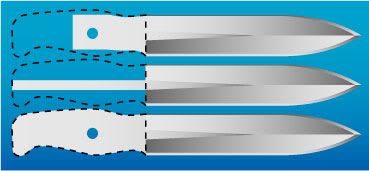
In the above drawing the dotted lines represent where the additional handle material would sit over the tang of the blades.
The top illustration is of a hidden tang, with a hole for a rivet or a screw, this could be a push tang inserted into a hole in the handle, or an encapsulated tang where the handle would be moulded over the tang. A hidden partial tang does not mean that the blade and handle are not bonded strongly or that it could break easily, this depends on the construction. A hidden partial tang can be useful when a knife with storage in the handle is desired (warning, many poorly made "survival knives" with storage are heavy and will break).
The middle drawing is of a hidden tang called the rat tail or stick tang that often goes into the entire length of the handle and is pressed, pinned, or threaded into the butt or pommel.
The bottom knife represents the full tang, where the blade material is often visible along the top and bottom of two halves of additional material. Obviously a strong connection is desired but a full tang is not necessary for good strong knife construction.
Blade Shapes (the profile of the blade)
Blade shape is important because the shape can determine what actions the knife is best suited for, say thrusting/stabbing, slicing, picking, carving, splitting, chopping, shaving and other uses.
There are as many shapes of knife blades as the human imagination, there are actually well over 20 standard blade shapes in almost every major knife makers catalog, but we will go over the most popular shapes for a "tool knife".
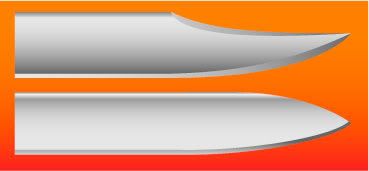
At the top the clip-point blade, and the bottom represents the drop point blade (with modifications called the pen knife blade).
The clip-point blade is currently the most popular blade shape sold in the US, the sharp edge formed by the tip shape makes this tip great for digging and picking, when the top tip is sharpened it can be used as a secondary cutting edge with an almost ripping effect.
The drop point blade presents a point with more metal and is less likely to break, but the fatter edge makes the point more shovel like and less able to get into small areas for picking, it does make a very good slicing blade that is able to take considerable tip abuse at the expense of tip stabbing penetration.
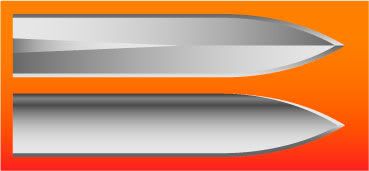
The two blade shapes above represent two versions of the spear point blade shape, the top is the double edged dagger and the bottom is a spear point where only the leading edge of the spine is sharpened. Obviously the spear point is not only strong but capable of powerful stabbing cuts and will slash along the entire blade.
The double edged dagger blades are notorious for abuse of their owners, a slip of the hand will produce deep cuts into the fingers or thumb of the user, remember a double edged blade cuts both directions on both sides! A spear point blade can be just as useful as a drop point blade, but a full double edged spear point is often considered an offensive weapon. Often an LEO may bypass a large hunting knife but the dagger points will always be viewed as "weapon only”.
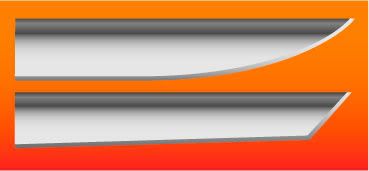
The top blade shape above is the simple swept point blade often called "normal", "simple point", or the "puukko" it has a straight top spine and a curved point, this is the starting shape for the clip point design, and is considered the simple general use and most popular blade shape in Europe. The utilitarian design of this point is undeniable, and works very well in the drawing, pull, and slicing strokes.
The bottom illustration is the asian inspired kissaki form (kamasu-kissaki) or "tanto" chisel point a type of point designed to punch into tough leather armor, this shape can be difficult to sharpen and is often regulated to martial arts students who desire an asian traditional blade designed for fighting and combat the blade design is awkward to most westerners.
Blade choice is far more complicated than you would think at first glance the choices seem almost endless. In the end, your desired use or what you think you will use the knife for is the final deciding equation.
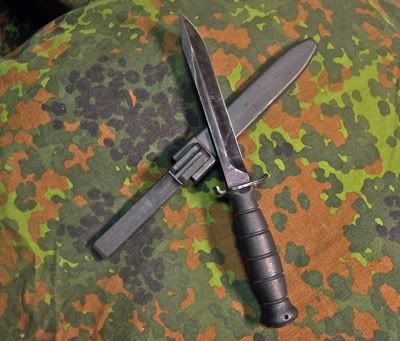
My personal choice is pictured above, a simple inexpensive (but reasonable quality) blade that can be attached to web gear or a belt. The "general use" knife is a tool. There are many examples of good quality (again reasonable quality) blades that are relatively inexpensive available on the market.
The Glock above (top) does feature this knife with a saw blade cut into the spine of the knife.
No comments:
Post a Comment